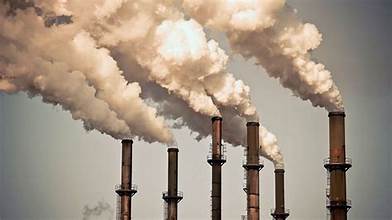All but one of the 100 cities with the world’s worst air pollution last year were in Asia, according to a new report, with the climate crisis playing a pivotal role in bad air quality that is risking the health of billions of people worldwide.
The vast majority of these cities — 83 — were in India and all exceeded the World Health Organization’s air quality guidelines by more than 10 times, according to the report by IQAir, which tracks air quality worldwide.
The study looked specifically at fine particulate matter, or PM2.5, which is the tiniest pollutant but also the most dangerous. Only 9% of more than 7,800 cities analyzed globally recorded air quality that met WHO’s standard, which says average annual levels of PM2.5 should not exceed 5 micrograms per cubic meter.
“We see that in every part of our lives that air pollution has an impact,” said IQAir Global CEO Frank Hammes. “And it typically, in some of the most polluted countries, is likely shaving off anywhere between three to six years of people’s lives. And then before that will lead to many years of suffering that are entirely preventable if there’s better air quality.”
When inhaled, PM2.5 travels deep into lung tissue where it can enter the bloodstream. It comes from sources like the combustion of fossil fuels, dust storms and wildfires, and has been linked to asthma, heart and lung disease, cancer, and other respiratory illneses, as well as cognitive impairment in children.
Begusarai, a city of half a million people in northern India’s Bihar state, was the world’s most polluted city last year with an average annual PM2.5 concentration of 118.9 — 23 times the WHO guidelines. It was followed in the IQAir rankings by the Indian cities of Guwahati, Assam; Delhi; and Mullanpur, Punjab.
Across India, 1.3 billion people, or 96% of the population, live with air quality seven times higher than WHO guidelines, according to the report.
Central and South Asia were the worst performing regions globally, home to all four of the most polluted countries last year: Bangladesh, Pakistan, India and Tajikistan.
South Asia is of particular concern, with 29 of the 30 most polluted cities in India, Pakistan or Bangladesh. The report ranked the major population centers of Lahore in 5th, New Delhi in 6th and Dhaka in 24th place.
Hammes said no significant improvement in pollution levels in the region is likely without “major changes in terms of the energy infrastructure and agricultural practices.”
“What’s also worrisome in many parts of the world is that the things that are causing outdoor air pollution are also sometimes the things that are causing indoor air pollution,” he added. “So cooking with dirty fuel will create indoor exposures that could be many times what you’re seeing outdoors.”
A global problem
IQAir found that 92.5% of the 7,812 locations in 134 countries, regions, and territories where it analyzed average air quality last year exceeded WHO’s PM2.5 guidelines.
Only 10 countries and territories had “healthy” air quality: Finland, Estonia, Puerto Rico, Australia, New Zealand, Bermuda, Grenada, Iceland, Mauritius and French Polynesia.
Millions of people die each year from air pollution-related health issues. Air pollution from fossil fuels is killing 5.1 million people worldwide every year, according to a study published in the BMJ in November. Meanwhile, WHO says 6.7 million people die annually from the combined effects of ambient and household air pollution.
The human-caused climate crisis, driven by the burning of fossil fuels, plays a “pivotal” role in influencing air pollution levels, the IQAir report said.
The climate crisis is altering weather patterns, leading to changes in wind and rainfall, which affects the dispersion of pollutants. Climate change will only make pollution worse as extreme heat becomes more severe and frequent, it said.
The climate crisis is also leading to more severe wildfires in many regions and longer and more intense pollen seasons, both of which exacerbate health issues linked to air pollution.
“We have such a strong overlap of what’s causing our climate crisis and what’s causing air pollution,” Hammes said. “Anything that we can do to reduce air pollution will be tremendously impactful in the long term also for improving our climate gas emissions, and vice versa.”
Regional rankings
North America was badly affected by wildfires that raged in Canada from May to October last year. In May, the monthly average of air pollution in Alberta was nine times greater than the same month in 2022, the report found.
And for the first time, Canada surpassed the United States in the regional pollution rankings.
The wildfires also affected US cities such as Minneapolis and Detroit, where annual pollution averages rose by 30% to 50% compared to the previous year. The most polluted major US city in 2023 was Columbus, Ohio for the second year running. But major cities like Portland, Seattle and Los Angeles experienced significant drops in annual average pollution levels, the report said.
In Asia, however, pollution levels rebounded across much of the region.
China reversed a five-year trend of declining levels of pollution, the report found. Chinese cities used to dominate global rankings of the world’s worst air quality but a raft of clean air policies over the past decade has transformed things for the better.
A study last year had found the campaign meant the average Chinese citizen’s lifespan is now 2.2 years longer. But thick smog returned to Beijing last year, where citizens experienced a 14% increase in the annual average PM2.5 concentration, according to the IQAir report. China’s most polluted city, Hotan, was listed at 14 in the IQAir ranking.
In Southeast Asia, only the Philippines saw a drop in annual pollution levels compared to the previous year, the report found.
Indonesia was the most polluted country in the region, with a 20% increase compared to 2022. Indonesia, Vietnam and Thailand all had cities that exceeded WHO PM2.5 guidelines by more than 10 times, according to the report.
Last month, Thai authorities ordered government employees to work from home due to unhealthy levels of pollution in the capital Bangkok and surrounding areas, according to Reuters. On Friday, tourism hot spot Chiang Mai was the world’s most polluted city as toxic smog brought by seasonal agricultural burning blanketed the northern city.
Inequality… and one bright spot
The report also highlighted a worrying inequality: the lack of monitoring stations in countries in Africa, South America and the Middle East, which results in a dearth of air quality data in those regions.
Although Africa saw an improvement in the number of countries included in this year’s report compared with previous years the continent largely remains the most underrepresented. According to IQAir, only 24 of 54 African countries had sufficient data available from their monitoring stations.
Seven African countries were among the new locations included in the 2023 rankings, including Burkina Faso, the world’s fifth most polluted country, and Rwanda, in 15th.
Several countries that ranked high on the most polluted list last year were not included for 2023 due to a lack of available data. They include Chad, which was the most polluted country in 2022.
“There is so much hidden air pollution still on the planet,” said Hammes.
One bright spot is increasing pressure and civic engagement from communities, NGOs, companies, and scientists to monitor air quality.
“Ultimately that’s great because it really shows governments that people do care,” Hammes said.
CNN






